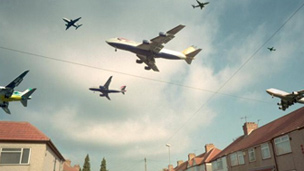Planes to fly closer in the wind 机场提议强风时飞机应凑近飞

Too close for comfort?
Vocabulary: air safety 词汇:空中安全
收听与下载
It may seem counterintuitive, but on windy days, aircraft should fly closer together. Those are the plans at Heathrow airport anyway.
The problem is that Heathrow is running at full capacity. It cannot process more than the 480,000 flights it currently handles per year. With flights booked throughout the day, there is no chance to make up for delays later in the morning as there is at quieter airports. And the biggest cause of these delays is wind.
In order to stay safe, airports leave gaps of several kilometres between landing aircraft. This is because as an aeroplane cuts through the sky it creates a vortex - a trail of churned up air - which is dangerous for other planes to fly through. For a large aircraft like the Boeing A380 the gap can be eleven kilometres.
However, planes measure their speed through the air, not over the ground. Therefore, if planes are flying into a headwind, scientists say the gap can be safely reduced. Imagine a plane is flying over the ground at 400 km per hour, but the air around the plane is moving in the opposite direction at 50 km per hour. That means the plane is actually only travelling at 350 km per hour through the air. By studying thousands of flying planes using lasers, scientists discovered that the wind also has the effect of quickly smoothing out their vortices.
The wind's slowing effect means that currently on windy days, arrivals at Heathrow drop from 45 per hour to as few as 32. With the new system that should be back up to 40 landings per hour.
Some people may feel nervous at the idea of flying closer together. To make sure the system is totally safe it has undergone four years of scientific research and safety testing. Designers now hope to sell the new system to the world's 25 busiest airports.
Glossary 词汇表 (点击单词收听发音)
- counterintuitive违反直觉的,不合常理的
- aircraft飞机
- full capacity全容量
- delay拖延
- vortex / vortices旋风,漩涡
- churn up搅拌
- therefore因此
- headwind逆风
- to imagine想象
- opposite direction相反方向
- laser激光
- smooth out减缓、消除
- effect效果,作用
- arrival抵达
- landing降落
- nervous感觉紧张
- undergo经过了
- safety testing安全测试

